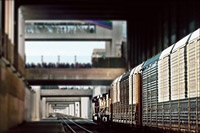TIFIAs and TIGERs and NIBs -- oh my! The alphabet soup of infrastructure funding mechanisms can be alienating even to committed transportation advocates. But with the power of the gas tax diminishing and elected officials refusing to raise it, other financing options are taking on increasing importance. If you're interested in reforming our transportation system for the 21st Century, it pays to know the differences between them.

Robert Puentes of the Brookings Institution's Metropolitan Policy Program says the current system is “both broke and broken,” meaning dramatic changes to the financing system are essential to get the kind of transportation system we want. "Minor tweaks are just not going to be enough," he said. "You could triple the bike program and that’s great, but it’s not going to solve the major challenges we’re facing as a nation. It’s all got to be run through an economic lens."
Puentes favors a National Infrastructure Bank, promoted by President Obama in his Labor Day speech, as a way to channel transportation investments strategically.
One person who will have a large role in shaping an infrastructure bank is California Senator Barbara Boxer, chair of the Senate Committee on Environment and Public Works. In a hearing this fall, Boxer challenged the idea of a National Infrastructure Bank, saying she’d prefer to see current financing programs strengthened. The program that Boxer wanted to see strengthened, instead of establishing a NIB, is known as TIFIA (Transportation Infrastructure Finance & Innovation Act).
So, you're probably wondering whether using TIFIA or a NIB to pay for infrastructure makes a difference. Is one mechanism better suited to building a safer, more efficient, and sustainable transportation system than the other?
TIFIA
TIFIA is a program of the Federal Highway Administration that provides credit assistance – not grants – for infrastructure projects. It doesn’t substitute for public spending or private investment – it’s a way to encourage private investment by providing loan security.
TIFIA has been around since 1998 but it’s come into greater use since the recession started eating away at state budgets. “They didn’t need it [before the recession] the same way they need it today,” says Puentes. “It’s oversubscribed, and so we need to figure out a way to choose TIFIA projects based on their merits.”
It’s not clear how the TIFIA program chooses projects to support, now that applications outnumber availability by a factor of more than eight to one. That’s one critique of the program: that it's not transparent enough in its decision-making.
The U.S. DOT has a proposal for TIFIA reform [PDF], but it refers to technicalities like repayment schedules and wage laws. Reformers say more dramatic, substantive reform would need to happen to make TIFIA a lever for change.
And many doubt that TIFIA can be as strong as it needs to be as long as it’s housed in the Department of Transportation. “Once something is created in DOT or in Treasury or anywhere else, it becomes part of someone’s jurisdiction, someone’s fiefdom,” says Scott Thomasson, an expert in infrastructure finance at the Progressive Policy Institute. “And there are people who want control of it and are going to fight if you try to change it too much.”
But could TIFIA be made into an independent entity? “That’s an institutional political fight you’re going to lose,” says Thomasson, “if you try to take away somebody’s baby.”
In our next post, we'll investigate the proposal to establish a National Infrastructure Bank, how it compares to TIFIA, and evaluate its pros and cons.





